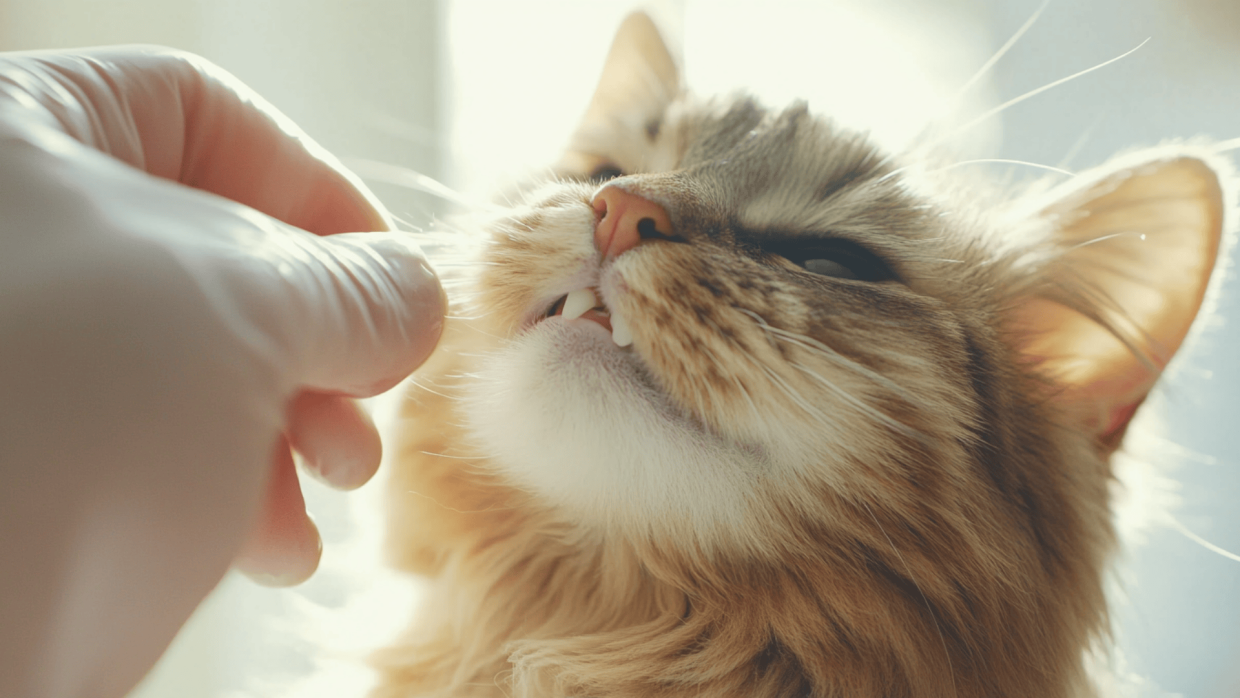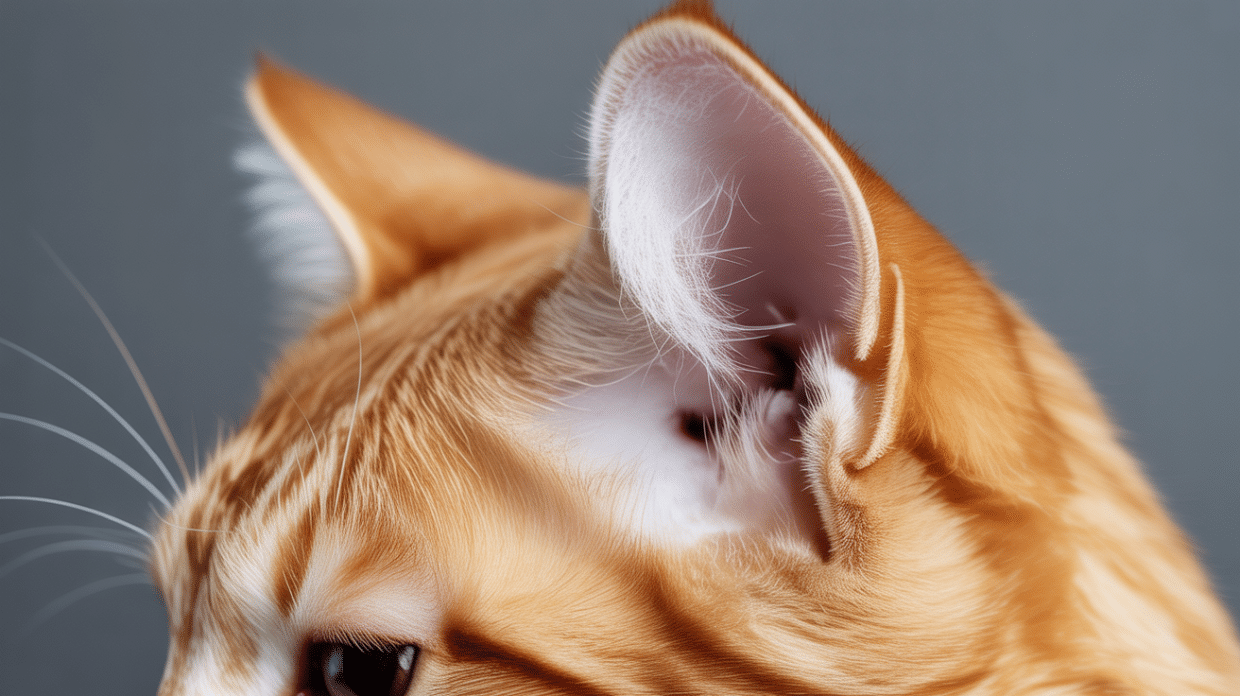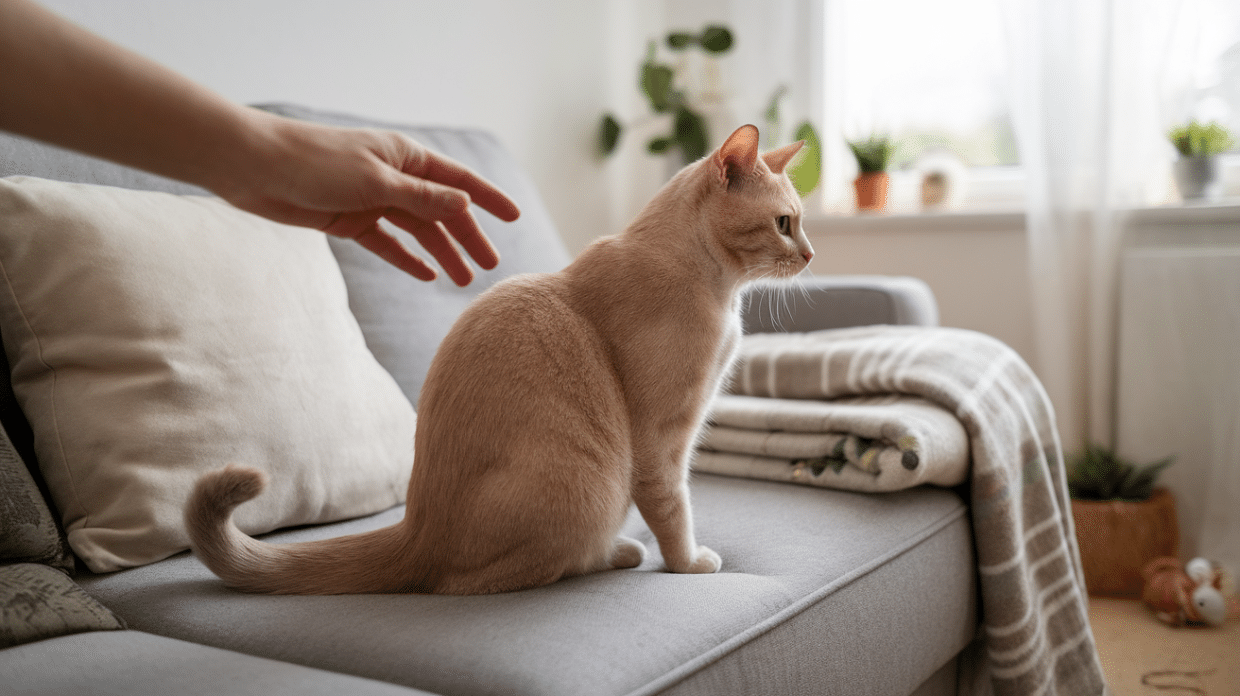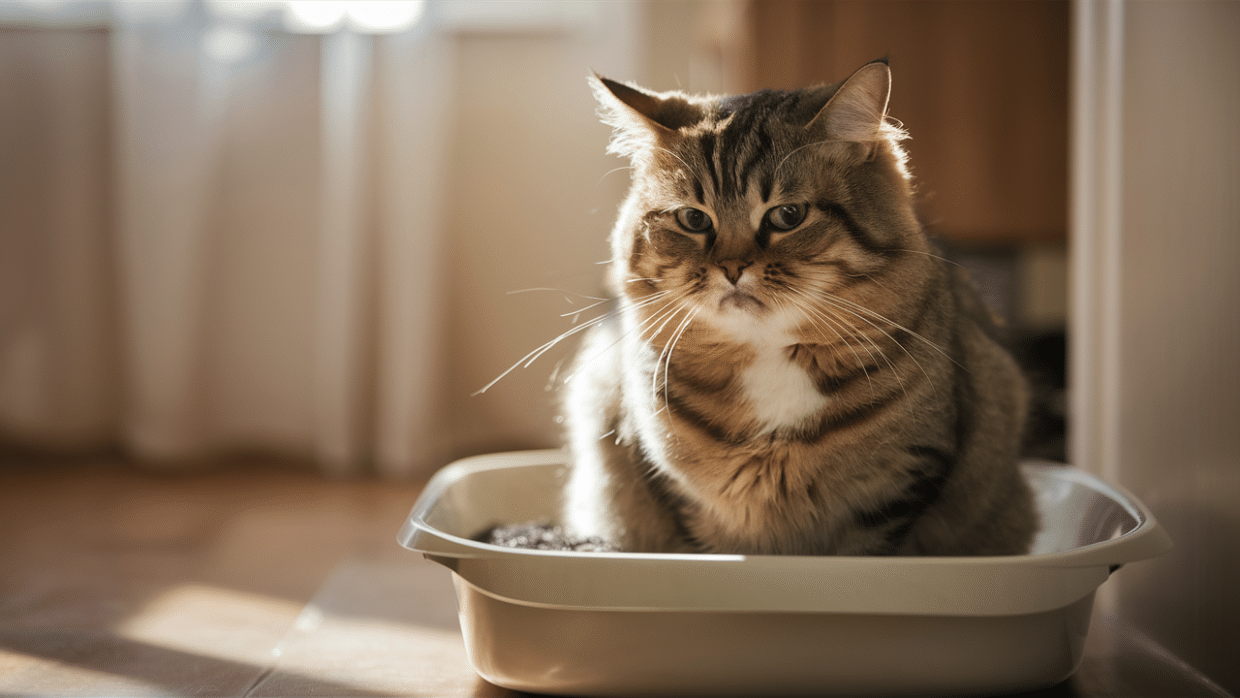Did you know that over half of all cats over age three have dental problems, and many cat parents don’t even realize it?
One of the most common (and confusing) issues is resorptive lesions in cats. If you’ve heard this term from your vet or noticed your cat having trouble eating, it can be hard to know what’s really going on.
This blog breaks it all down in simple, easy-to-understand language. You’ll learn what resorptive lesions are, what causes them, what signs to watch for, and how they’re treated.
By the end, you’ll have a clear idea of what to do next and how to help your cat feel better.
Ready to find out what’s happening beneath the surface of those tiny teeth?
What are Resorptive Lesions in Cats?
Resorptive lesions in cats, also known as feline odontoclastic resorptive lesions (FORLs), are a painful dental condition where a cat’s body begins breaking down and absorbing parts of its own teeth.
This usually starts near the gum line and can slowly damage both the crown and the root of the tooth.
The process is driven by specialized cells called odontoclasts, which are meant to help with normal tooth growth and changes, but in this case, they go too far.
As the tooth breaks down, holes can form, the tooth structure weakens, and nerves may become exposed, causing pain.
Resorptive lesions are different from regular cavities. Bacteria and plaque cause cavities, while FORLs are not triggered by outside infection.
They’re more like an internal breakdown that can’t be reversed. Without treatment, the tooth may break or become so painful that the cat stops eating normally.
How Common are they?
Resorptive lesions are one of the most common dental problems in cats, and they often go undetected until they cause serious discomfort.
Studies show that 30% to 60% of cats will have at least one resorptive lesion in their lifetime. For cats over age five, that number jumps to about 75%.
These lesions can affect any tooth, but the third premolars in the lower jaw are the most frequently involved. Many cats show no obvious signs at first, which makes early detection tough without regular dental exams.
The risk increases with age. Cats over three years old are more likely to develop them, and those over five are at the highest risk. Routine checkups, especially after age three, are important for spotting signs early.
Since these lesions can be painful, knowing how common they are helps cat owners understand why dental care and regular vet visits are so important.
Causes and Risk Factors
The exact cause of resorptive lesions in cats isn’t fully understood, but experts have several ideas.
One of the strongest theories is that inflammation in the gums or mouth may trigger the body to start breaking down the tooth.
Inflammatory cells can accidentally activate odontoclasts, the cells that dissolve bone and tooth material.
Genetics could also be involved. Certain breeds, such as Siamese, Persian, and Abyssinian cats, appear to be more susceptible to the condition.
This suggests that inherited traits might influence how a cat’s immune or dental system reacts over time.
Other possible risk factors include diet, especially diets high in acid or lacking in nutrients. Some vets believe cats that mostly eat dry food may be more at risk, while others suggest poor dental hygiene could be a factor.
Hormonal changes, past dental injuries, and other health conditions may also play a role, but more research is needed to confirm these links.
Built-up plaque and tartar on cats’ teeth may increase inflammation and play a role in triggering resorptive lesions.
Symptoms to Watch For
Resorptive lesions can be tricky to spot because many cats hide pain well. However, if you know what to look for, you can catch the signs early and help your cat feel better more quickly.
Early warning signs include:
- Drooling more than usual
- Bad breath (even after dental cleanings)
- Red or swollen gums near a tooth
- Light bleeding when chewing or eating
As the condition gets worse, advanced symptoms may show up:
- Visible holes in the teeth, especially near the gum line
- A cracked or broken tooth
- Blood on toys, food, or water bowls
- Difficulty chewing, especially dry food
Behavioral changes can also be clues:
- Chewing on only one side of the mouth
- Avoiding food or acting picky
- Pawing at the mouth
- Acting more withdrawn or irritable
If you notice any of these symptoms, it’s a good idea to schedule a vet visit and get your cat’s mouth checked.
Types and Stages of Lesions
Resorptive lesions aren’t all the same. They vary in how they affect the tooth, especially when it comes to the root. Understanding the type and stage of a lesion helps vets decide the best treatment option for your cat.
Type 1 vs. Type 2
Resorptive lesions are divided into two types based on how much of the tooth, especially the root, is affected.
Type 1 lesions involve clear damage to the crown (the visible part of the tooth) while the root remains mostly normal. The tooth still has its usual shape and space in the jawbone.
Treatment: A full tooth extraction is needed. Since the root is still solid, it has to be completely removed.
Type 2 lesions cause the root to break down along with the crown. The root starts fusing with the surrounding bone, making it harder to separate.
Treatment: In these cases, vets often perform a crown amputation. That means they remove the top part of the tooth but leave the root in place, since it’s already being absorbed.
Sometimes a tooth can have features of both types; this is called Type 3, though it’s not always used as an official category. Treatment depends on which part of the tooth is more affected.
Knowing the type of lesion helps the vet plan a safer and more effective procedure, with less pain and faster healing for your cat.
Stages of Tooth Resorption
Lesions also go through different stages, based on how much of the tooth has been damaged. Here’s a breakdown of the five main stages:
Stage 1
- Minor damage to the tooth enamel
- No visible symptoms yet
- Often found by accident during a dental exam
Stage 2
- The enamel and dentin (inner tooth layer) are affected
- Pain may begin, though the signs are still hard to notice
Stage 3
- The damage reaches the pulp (where nerves and blood vessels live)
- Pain increases
- The cat may show signs like drooling, pawing at the mouth, or avoiding food
Stage 4
- Large parts of the crown are destroyed
- A tooth may break or become loose
- Severe pain and eating problems are common
Stage 5
- Most of the tooth is gone
- Only root fragments remain
- The root is often absorbed by the jawbone
Most cats don’t show signs in Stage 1 or 2. That’s why regular dental X-rays are so important; many lesions are invisible without them.
Catching resorptive lesions early can make a big difference in your cat’s comfort and long-term health.
How Vets Diagnose Resorptive Lesions
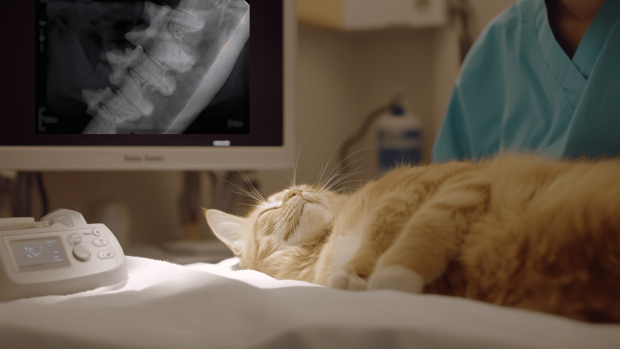
Most resorptive lesions aren’t visible just by looking inside your cat’s mouth. That’s why X-rays are essential for a proper diagnosis. Even if the crown of the tooth looks fine, the root could already be breaking down under the surface.
X-rays help reveal hidden lesions below the gum line. These are often the ones that cause the most pain because they’re harder to spot until the condition is advanced.
They also show root damage and bone changes that can’t be seen during a visual exam. In some cases, the root may already be dissolving or fusing with the bone, which affects treatment decisions.
Vets use X-rays to figure out the type of lesion: Type 1 or Type 2. Knowing the type helps them choose between full extraction and crown amputation.
Finally, X-rays show how far the damage has spread. This is key for deciding which teeth need treatment and which ones can be monitored for now.
Without dental X-rays, many lesions go unnoticed until they cause serious pain.
So what actually happens during a dental exam?
- First, your cat is placed under anesthesia to keep them calm and still
- The vet will clean the teeth and check for visible damage
- Each tooth is examined closely, especially near the gum line
- Full-mouth dental X-rays are taken
- Based on what they see, the vet will plan treatment
A full dental exam gives a complete picture of your cat’s oral health, not just the parts you can see.
When to See a Vet
If your cat is drooling, bleeding from the mouth, avoiding food, or showing sudden changes in behavior, it’s time to see the vet. These are often signs of pain from a damaged tooth.
Before the visit, watch for changes in eating or grooming habits and jot down any symptoms. Bring past dental records if available. Avoid feeding your cat that morning in case anesthesia is needed.
Early vet care can stop the pain from getting worse and help your cat feel better faster.
Treatment Options
Resorptive lesions won’t heal on their own. To stop the pain and prevent more damage, vets typically treat them with either tooth extraction or crown amputation, depending on the type and stage.
Tooth Extraction
Tooth extraction is used when the root is still healthy and intact, which is common in Type 1 lesions.
The vet removes the whole tooth while your cat is under anesthesia. If needed, multiple teeth can be removed in one session.
Recovery is usually quick. Cats may need pain meds and soft food for a few days. Most cats eat better once the painful tooth is gone.
Crown Amputation
Crown amputation is used for Type 2 lesions, where the bone is already absorbing the root. Only the crown is removed. The root stays in place, as removing it could cause more harm.
Pros:
- Less surgery time
- Easier healing
Cons:
- Not safe if infection is present
- Needs follow-up X-rays to check healing
The vet chooses the best option based on your cat’s exam and X-rays.
What Happens if Left Untreated?
If resorptive lesions aren’t treated, they keep getting worse. What starts as a small defect can grow into deep damage that reaches the nerve. This causes ongoing pain, even if your cat doesn’t show it.
As the lesion spreads, the tooth may break or fall apart. Your cat might stop chewing on that side, drop food, or avoid eating altogether. In some cases, untreated lesions can lead to gum infections or swelling in the jaw.
Over time, the pain can affect your cat’s mood, behavior, and overall health. Some cats become withdrawn or lose weight simply because it hurts too much to eat.
Early treatment helps avoid serious problems and keeps your cat comfortable.
Can Resorptive Lesions Be Prevented?
There’s no guaranteed way to prevent resorptive lesions, but you can lower the risk and catch problems early with a few simple steps.
Routine dental exams are key. Yearly vet checkups and full dental X-rays when necessary help identify lesions before they worsen.
Diet may also play a role. A balanced diet with good-quality cat food supports dental and overall health. Some vets suggest mixing wet and dry food or using dental treats that reduce plaque.
At home, monitor for signs like drooling, bad breath, or changes in chewing. Keep an eye on your cat’s behavior and eating habits. Small changes can be early clues that something’s wrong.
Staying on top of dental care gives your cat the best shot at a healthy, pain-free mouth.
Conclusion
Resorptive lesions in cats can be hard to spot, but now you know what they are, why they matter, and how to help your cat feel better. If your cat shows signs like drooling or avoiding food, it’s time to take a closer look.
Catching these lesions early can make a big difference in your cat’s comfort and health. Even small changes in behavior could mean it’s time for a vet visit.
Remember, regular dental checkups are one of the best ways to catch problems before they get worse.
Want to learn more about caring for your cat’s health? Check out our other blogs for simple, helpful tips every cat owner should know.

